From Compass to Carousel
Thursday 26th August 2021
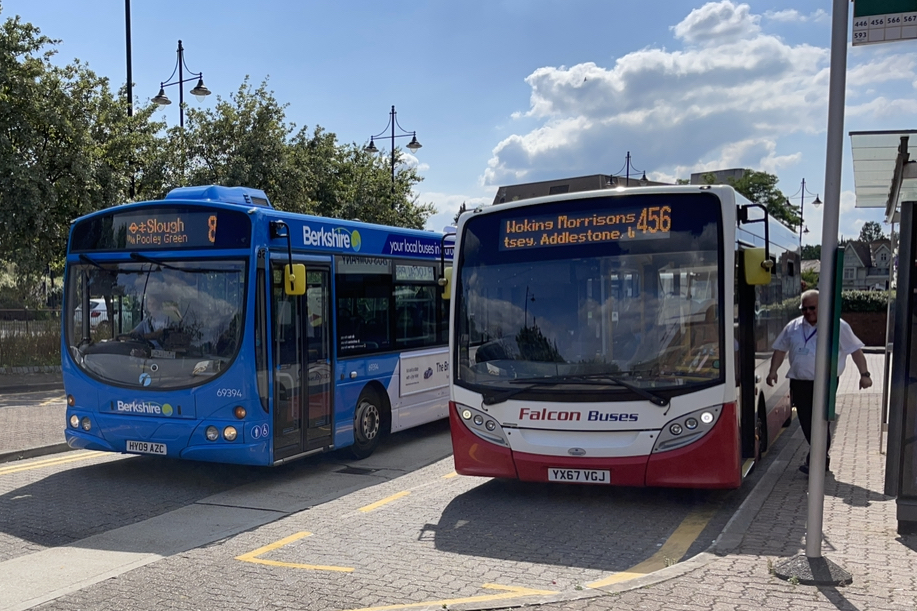
The LCBS Anniversary Tour Gang of Four (now joined by Mike Best and David Cole to make Six of the Best) reconvened on Tuesday to continue our wander around that much missed company’s Polo mint operating area taking us from Dorking Station (where we left off last time) through Surrey and Berkshire to Amersham Station in Buckinghamshire; completing our visit to the south west quadrant and entering north western territory.

There’s not much left of the London Country heritage in these parts. Guildford bus garage survives and houses the Arriva Surrey outpost but all the other bus garages and most bus stations have disappeared as stockbroker belt land values didn’t favour the economics of bus operation from the 1970s onwards.
A myriad of different operators have come and gone since London Country South West lost its preeminence, was purchased by British Bus, then Cowie and morphed into Arriva.
I’ve remarked in previous blogs things now look better in this part of the former LCBS area than for many years with some top quality independently owned bus companies together with a County Council which still knows what it’s doing when it comes to actively supporting public transport whilst under relentless financial pressures.
As always with these trips we came across the very good, the good and the not-so-good as well as the downright awful. I’ll run through the itinerary and what we found as we reminisced about how it would have been fifty (one) years ago.

First up was a journey on Compass Travel’s route 32 which provides an hourly timetable mostly along the east-west A25 linking Redhill, Reigate, Dorking and Guildford. It replicates the former long standing hourly LCBS route 425 between Dorking and Guildford, as well as much of the route east of Dorking to Redhill.

Compass Travel is another independently owned quality bus business that’s carved out a niche running mainly tendered bus routes. Tender success over the years and the demise of some operators of dubious quality now means Compass operates across a large geographic area including East Sussex, Brighton, West Sussex and Surrey as well as into Tunbridge Wells in Kent.
Its ADL E200 bus arrived from Redhill at our starting point outside Dorking Station a couple of minutes after the scheduled 09:56 but we soon made up that time with the pause time built in at the bus stop outside the White Horse in Dorking’s main shopping street being a very longstanding LCBS timing point.
As we left Dorking we passed the site of London Country’s bus garage in the town which also fed into Green Line routes 712, 713 and 714 to Dunstable and Luton and long given over to flats.

Sadly it was an all too typically quiet journey for passengers. We brought three passengers into Dorking and picked three and a dog up who weren’t on the bus for long, picking another up in Gomshall, another in Shere and three in Chilworth. Everyone travelled through to Guildford including a woman who was already on board at Dorking Station – she won the prize for the longest journey we saw anyone make all day.
Not long out of Dorking you spot a rather nice thatched roofed bus shelter which could well be from LCBS (if not LT) days.
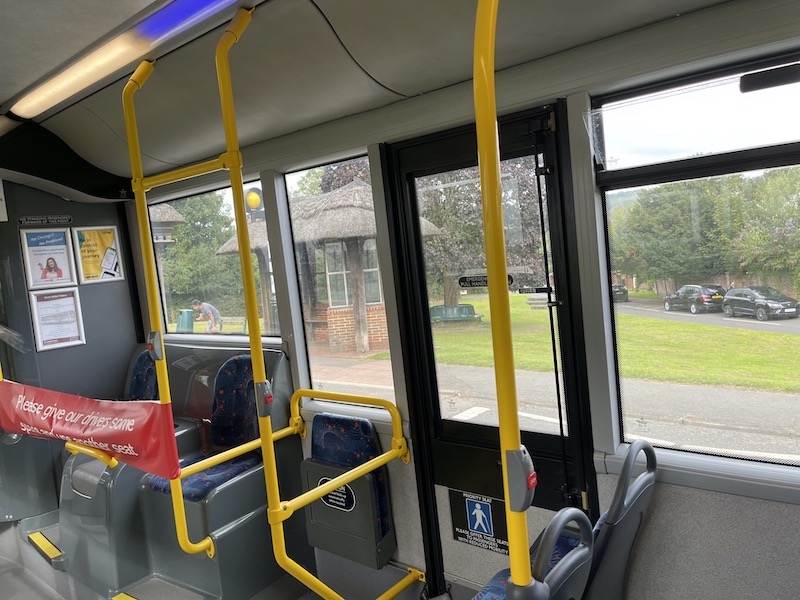
Another stand out feature on this journey, aside from where the A25 narrows under the railway bridge at Gomshall (see below), was the on board rattle noise.

Boy did that bus rattle. It really rattled. And pleasant though the journey is along the A25 and through Chilworth and Shalford it was a relief to arrive at Guildford’s dreary Friary bus station just a couple of minutes after the scheduled 10:44 arrival and be spared that rattle sound.

Guildford wins the prize for the most downbeat bus station so far but there’s going to be some stiff competition in Part 3 of this Tour for that accolade. I pointed out Surrey County Council’s impressive display of timetables to my travelling colleagues and Ray Stenning as always with an eye to design failings rightly pointed out the presentation is neither helpful for the uninitiated nor aesthetic. It’s like many bus company websites, you need to know a significant amount about the information you’re seeking (eg the bus route number and where it goes) before you can find the answer.

I’ve remarked in recent blogs about the closed travel office in Guildford bus station so won’t labour the point here except to say we noticed staff going in and out of it and someone behind the counter still in situ inside. A most extraordinary state of affairs that a commercial business seeking to attract passengers can’t give any priority to helping them, if needed, even though staff are on site.
Guildford was the southern terminus of the long standing Green Line route 715 to Hertford which is still remembered by Stagecoach using the number to run hourly as far as Kingston, albeit the original 715 by-passed it, but it’s good to see it replicating most of the route. It’s also noteworthy it’s the only former LCBS route which Stagecoach has an interest in fifty years later.
Guildford was also where London Country met Aldershot and District and it was a former A&D route to Woking we travelled on next.

To replicate a former London Country bus route between Guildford and Woking would have taken us in a north easterly direction to Ripley before continuing via Send to Woking – now operated by White Bus routes 462/463. I described these routes in my ‘Seven ways to Woking (from Guildford)’ adventure last October. They’re operated by White Bus which is another operator expanding in this part of the former LCBS territory and doing so with a brilliant quality offering of clean, well presented buses and a very new fleet too.

Sadly the connecting timings in Guildford from the 32 were just a bit too tight for comfort and would have meant an hour’s wait, so instead we opted for Arriva route 34 taking a more direct route via Jacobs Well, Sutton Green and Westfield.

Route 34 is operated by Arriva and not unexpectedly the Mercedes Citaro we encountered on the journey leaving Giuldford at 11:08 heading to Woking and on to Camberley had seen better days and was exhibitng the all too famailair signs of neglect.

Cobwebs on window sills, filthy roof panels, including one not fixed properly and annoyingly rattling the whole journey as well as the usual plethora of notices including one on top of another, on top of yet another – being the original poster promoting Green Line 724 on which route the bus used to run between Harlow and Heathrow Airport – hence the extensive luggage racks, left in situ, and not particularly needed between Guildford and Camberley.

Goodness knows how anyone is supposed to read some of these notices….

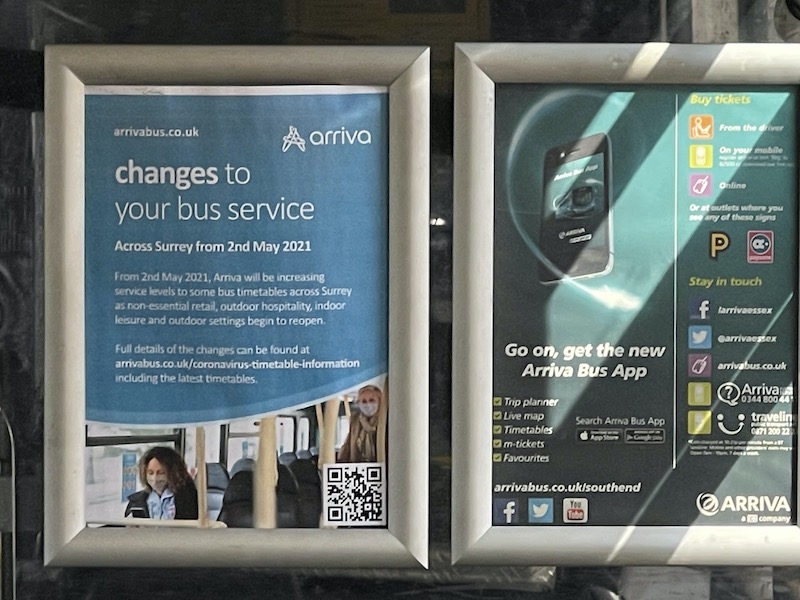
We took four passengers out of Guildford but only a couple stayed on for the entire journey with a few more boarding as we approached Woking.

The driver drove well but she told us as we alighted in Woking on time at 11:46 there was a problem with the gearbox and she’d be logging it off for it to be seen to. Let’s hope while it was in the garage it got a good clean and poster sort out too. And that roof panel tightened and the rest cleaned.

We took a refreshment break in Woking to recover from that experience before our next journey – route 456 to Staines operated by yet another small independently owned company doing a grand job in this area – Falcon Buses.

This route is a very close replication of the former LCBS route 436 which, like the 456 today, ran via Addlestone and Chertsey (see earlier map above). Route 436 together with the 420 and 463 were operated by the former London Transport low height RLH class with sunken upper deck offside gangway. Our 456 leaving Woking at 12:43 on Tuesday was however in the hands of a more modern bus – a smart looking ADL Enviro 200.
Addlestone was home to another LCBS garage (code WY for nearby Weybridge) now obviously replaced by residential properties and provided vehicles for Green Line routes 716 (from Chertsey) and 716A (from Woking) which crossed London to Stevenage and Hitchin.
Our 456 was another typical journey for passenger loading; aside from ourselves, numbering about seven on board as a maximum. It wasn’t a rushed journey either, with pauses in Addlestone and Chertsey as well as other points along the route to keep to schedule. We arrived into Staines bus station on time at 13:56 after a 73 minute journey. Our longest of the day.
Staines also used to have an LCBS bus garage as well as enjoying the presence of London Transport’s red bus routes from Hounslow and Kingston, which it still does today.

It’s also where buses now run in Diamond branding can be found which until earlier this year would use the Hallmark company branding.

From Staines we continued on into Berkshire taking First Bus operated route 8 which has a U shape pattern from Heathrow Airport down to Staines and then via Egham and Englefield Green to Old Windsor, Windsor and Slough just like the former LCBS route 441 had done on its way to High Wycombe – but for us, fifty years on, we had to make a change of bus in Slough to reach High Wycombe.

Our bus on today’s route 8 sported the brand new generic First Berkshire branding for Slough’s local routes.
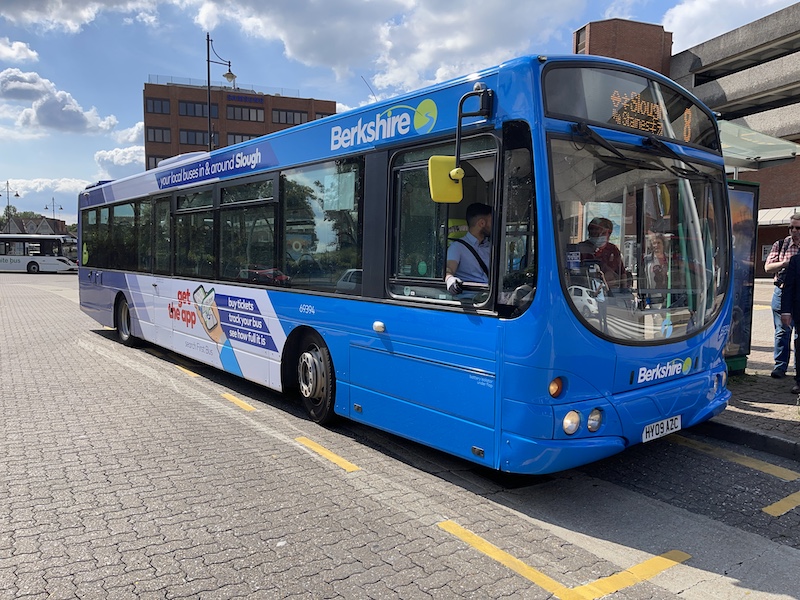
Even better than that, the interior had a makeover by a professional design expert who just happened to be travelling with us (guess who) and was able to explain the thinking behind every part of the process and the resultant masterpiece.
This ranges from creating a two tone floor effect to differentiate the ‘public’ area from the ‘private’ area…

… using the space behind the driver for a creative display rather than a plethora of ‘don’t do this or that’ notices no-one every reads …

… and a whole range of fun facts and images to show the heritage and highlights of Slough where the bus is based as well as planes heading towards nearby Heathrow.




We carried a reasonable number on this quite busy route even getting up to twelve on board which was a record for the day’s tour so far.
It was also noteworthy that a couple on board were spotting the different cove panel messages and reading them.
Passing through Windsor reminded us it was the western terminus of Green Line routes 704 and 705 to Sevenoaks and Tunbridge Wells as well as the 718 to Harlow and the 725 which skirted around the south via Sutton, Croydon and Bromley to Gravesend. It was another town which once had a lovely LCBS garage now inevitably replaced by housing.
We’d left Staines at 14:14 and arrived into Slough at 15:20 and was the only journey to run significantly late, being ten minutes later than scheduled on arrival. But it was made up for by the lovely designed interior and comfortable seats!

Well done to First Berkshire for that initiative, but the company also gets a booby prize for our next bus displaying three cove panels (the only three on the bus) promoting a “Free Family Open Day” at ‘The Centre’ which “IS OPENING SOON” – except the opening date is Monday 25th March ….. 2019 – almost two and a half years ago. It won the prize for the most out of date notice, despite some earlier stiff competition from Arriva in Surrey.

We’d made a quick five minute change of bus in the modernist concrete inspired bus station in Slough (and yes, it is better than the old one) on to First Berkshire’s route X74 which links Slough with High Wycombe, our next destination, every half hour.
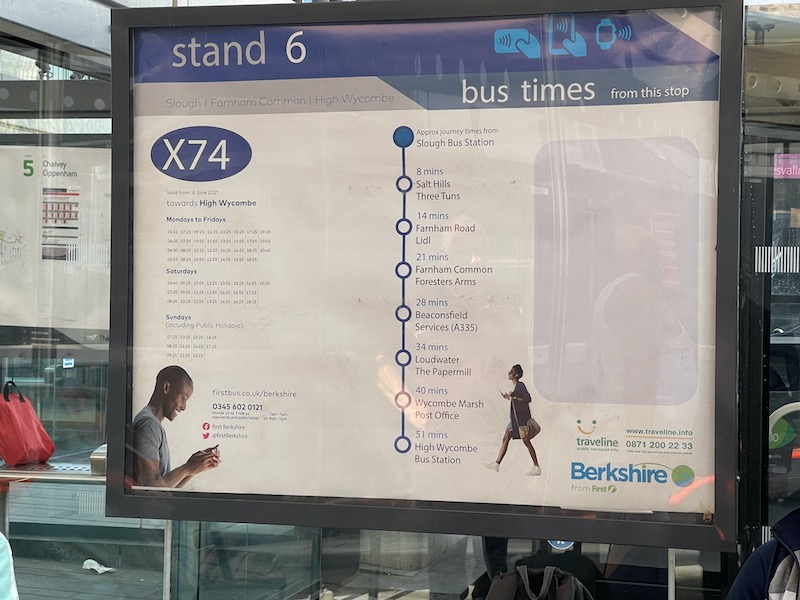
The route leaves Slough westwards on the Bath Road but before long heads due north via Farnham Common as the already mentioned London Country route 441 would have done but whereas that route then ran via Beaconsfield before heading west to Loudwater and High Wycombe, the X74 smartly nips on to the M40 between junctions 2 and 3 by-passing Beaconsfield before rejoining the old A40 continuing via Loudwater rejoining the 441 route.
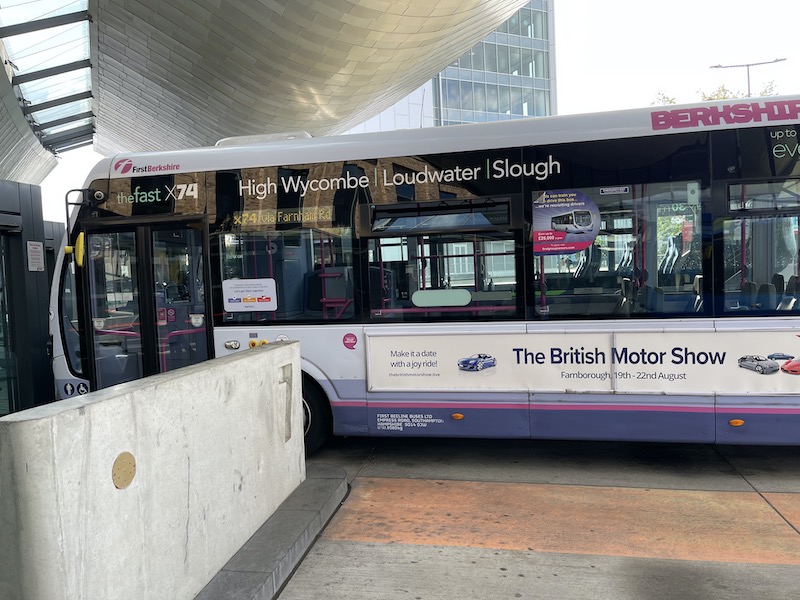
We caught the 15:25 from Slough and a few passengers got off at stops as we left the built up area but once we continued through Farnham Common there were only three left on board and one of those alighted opposite the services just before we joined the M40.

I’m not sure how much that speeding up and bypassing Beaconsfield is generating passengers. On the strength of Tuesday’s experience ‘not a lot’.
It was also the most expensive journey of our Tour by far. My colleagues who were paying their way had to shell out a pricey £7 for the 49 minute journey. It doesn’t compare too well with the £9 Discovery ticket which sustained the fare payers for the entirety of Part 1 (Gravesend to Dorking) a fortnight previously and the journeys on Tuesday from Dorking to Slough in Part 2.
However, on the positive side, the best part of this journey was passing the only (to our knowledge – unless readers know of another one) original London Transport bus shelter still in situ at the northbound bus stop at the end of the oddly names One Pin Lane.

A true memory jerker.
The Wright Streetlite branded for route X74 wasn’t as rattle prone as our earlier travels with ADL’s buses and got us into High Wycombe on time at 16:14.
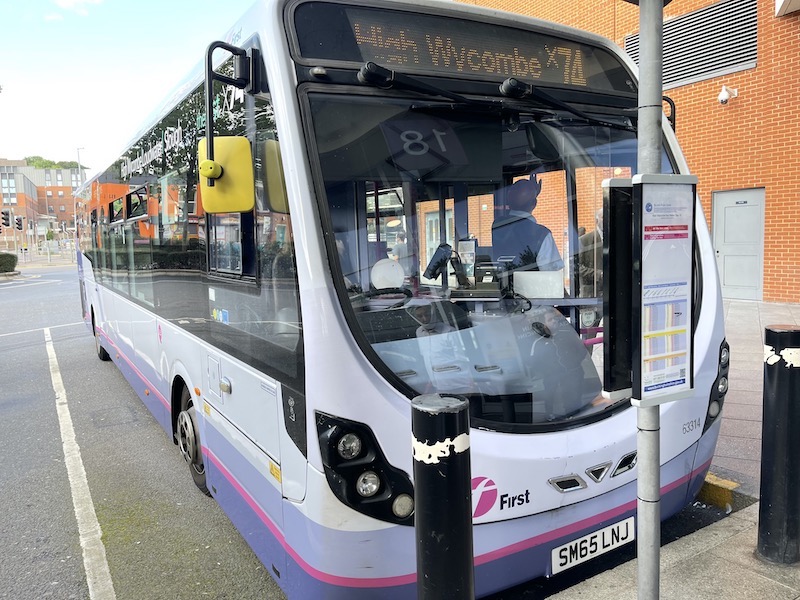
Another Home Counties town with another long closed LCBS bus garage and an outer terminus of two Green Line routes – the 711 to Reigate and, for a short time, the 724, before it got switched to the more logical western destination of Heathrow Airport.
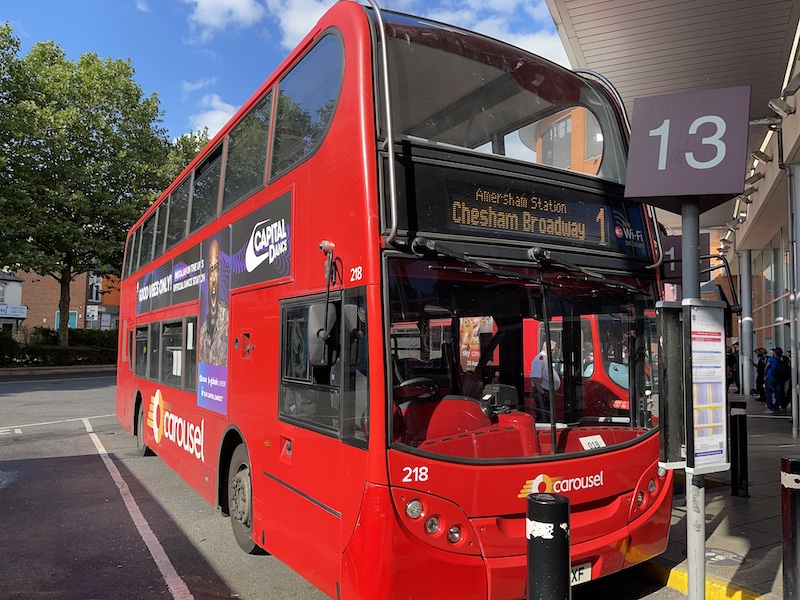
And so to our final bus for part two of our Tour – and our very first double decker courtesy of Carousel the sister bus company to Go-Ahead owned Oxford Bus which operates a number of former LCBS routes in this part of the Chilterns, not least the network heading down the A40 towards Beaconsfield and Gerrards Cross numbered in the 101-108 series and branded Chiltern Hundreds.
Our route is a rare jointly operated service with Arriva – branded as ‘the one’ and numbered, funnily enough, route 1. After a spell of competition between the two companies, the arrangement on the route is now a coordinated timetable and smartly promoted joint ticketing which expands to all routes in the “Wycombe SMART zone“.
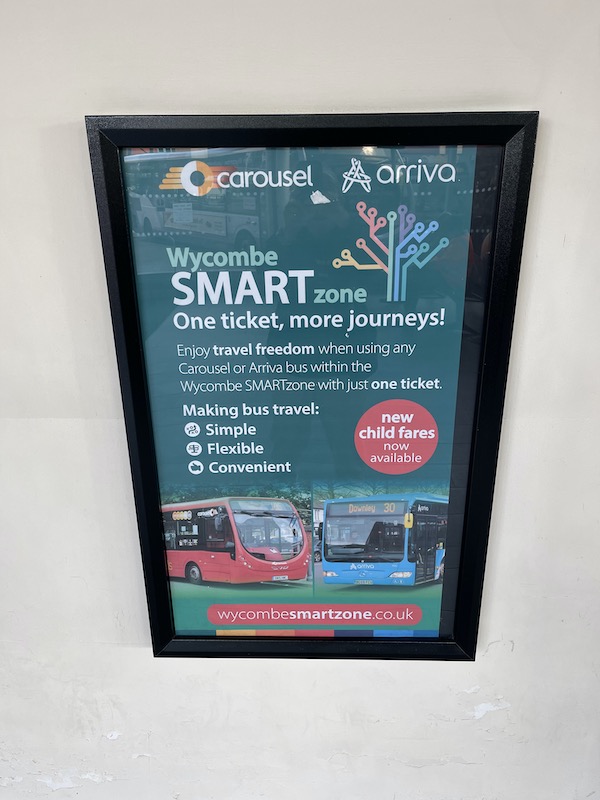
The Scania bus we travelled on had been nicely refurbished after seeing service with its ‘parent operator’ Oxford Bus, but had lost the full effect of the replica LCBS logo, by missing the bottom bit due to the replacement of a panel with no vinyl.
We caught the 16:25 from High Wycombe and noticed the route replicates much of the former London Country route 362/A via Holmer Green to Amersham – we’re now in the northern 300 series of routes of the former LCBS having left the southern 400 series.

Route 1 operates every 15 minutes being the most frequent and the busiest of the journeys we travelled on. It was certainly good to have a double decker to make sure we could all travel and keep socially distanced from other passengers on board but some journeys on the route are still single deck and branded too.

Alternate journeys are run by Carousel and Arriva between High Wycombe, Amersham and Chesham with one Carousel journey each hour continuing via Bovingdon to Hemel Hempstead providing a much better link to that Hertfordshire town from the Chilterns than LCBS ever managed.
Towards Amersham we passed a site where work is advancing to build HS2…

… and in Amersham Old Town we spotted the site of the much missed former LCBS bus garage in the High Street now appropriately enough replaced by retirement flats. Green Line route 710 was based there and once ran from Chesham and Amersham to Crawley.
Update: see comments below.

After passing along a residential area along Stanley Hill we arrived at Amersham Station on time at 17:13 and wandered over to the adjacent terminus station of the Metropolitan Line and the Chiltern line to Aylesbury, together with its rather understated entrance, to head back to our homes having enjoyed another quartile of travels around the former LCBS area.

Part 3 will follow later next month.
Roger French




Thoroughly enjoying your circumnavigation of the LCBS area . . . you’re fast approaching my locale . . . I’m intrigued how you’re going to get to Tring from Amersham!!
One tiny correction . . . the flats illustrated in Amersham are actually on the site of the original “Amersham and District” bus Garage, which outlasted the 1935 LT bus Garage. The LT version was more-or-less on the site of the adjacent Tesco petrol station and was reduced to outstation status in late-1989 when the bulk of the operation was moved to the then-BRS site on West Wycombe Road. The original LT garage in High Wycombe is still there, at the bottom of Marlow Hill !!
LikeLiked by 1 person
Thanks for that info – our collective memories are showing their age!
LikeLike
Lest we forget, the 703 to Wrotham and 709 to Caterham-on-the-Hill (for MA Crews) Green Lines also ran from Amersham garage in it’s heyday. And like unfortunate Edgware on Central Buses, was the first Country bus garage to go entirely to one man operation in the early ’70s. But interestingly, many of the long-serving women Conductors happily took the redundancy money, walked up the hill and re-joined London Transport as Metropolitan (underground) line staff, easing what had always been an acute staffing problem in the area.
LikeLike
I thought RD (Hornchurch) was the first central all OMO (OPO for politically correct readers) garage.. the 113 was still crew from EW
LikeLike
Another reminder for me of the times I would buy a Green Rover and go exploring.
I await Part 3 with great relish…
LikeLike
Another great and sad episode on your journey. Good to see mention of the exhorbitant single fares! Having complained about Guildford bus station I’m intrigued what you’ll have to say about horrendous Harlow!
LikeLike
We’ve got Aylesbury to suffer before Harlow! 😳
LikeLike
I can’t help but feel that quite a number of operators set their cash fares at a level that brings in the income they need from concessionary passes. With the majority of off-peak travel on provincial buses – verging on the overwhelming majority – being pass-holders, high cash fares might deter a handful of passengers but if it brings in more 50% money for 90% of passengers then unfortunately it’s a no-brainer for them.
LikeLike
I’m only guessing, but is this how the companies are “gaming” the concession reimbursement…?
eg: Farebox requirement £3.20
So charge £7 single & £7.10 return/zone pass….
The reimbursement per ENCTS is going to be approaching £3.20, (£7 x , say, 42%=£2.94) so that’s just about ok, and your actual fare paying passenger on a RETURN isn’t going to be too much out of pocket either, paying 70p over the odds, but the real loser is the passenger who only wants a single, who is forced to overpay by a whopping 218%!!
Could a “buy your ticket on the app” passenger be offered a 50% discount on the single fare perhaps for using the app and speeding up boarding, £3.50, as the ENCTS fare used for reimbursement is always going to be the on bus cash fare, and that would then make everyone roughly right??
I realise the council reimbursement people aren’t complete fools, but if the cash on the bus fare is £7, then what can they do?
If the reimbursement rate was a bit higher/closer to a realistic figure that it was always supposed to be, then I guess the fares for paying passengers could be a little closer to what they should be, without such a twirly supplement necessary!
I wouldn’t mind so much, but I won’t be enjoying my twirly pass at anything like 60 years of age, unlike those sprightly sexagenarians I’ve had to watch getting a free ride since 2008….
LikeLike
Hi Rodger
Thanks for the lovely comments on our First Berkshire number 8 Route… if I had known you was in Slough I would of come and seen you and given you a tour of our depot and garage… next time send me a message when your in our neighbourhood…
Lovely write up
Steve Ponting
LikeLiked by 1 person
Another interesting read, thank you.
The thatched bus stop you saw outside Dorking was the Eastbound stop at Westcott.
It makes a nice photo – if a bus actually stops, and the busy traffic breaks long enough to get a clear shot!
LikeLike
It seems to have always been presumed that the garage code WY was based on Addlestone’s proximity to Weybridge. But I have often wondered, could it possibly have actually originated in the fact that buses were outstationed at the Weymann factory 500 yards up the road prior to Addlestone opening?
Looking forward to your next instalment.
LikeLiked by 1 person
Steve; apparently this was indeed the reason for the code WY; and not standing for nearby Weybridge.
LikeLike
Whilst I don’t have the exact dates to hand, I can assure Mackay that Edgware was the first to go all OMO/OPO when they lost the 292. The 113s presumably were out of Hendon at that time, but again don’t have the facts at hand. Ironically, crew operation returned in later years when the 13 was allocated there, but I am not a London historian, so only going by memory. I also query the reason for the WY (Addlestone) code. “AD” of course could not be used as already allocated, and being so close to Weybridge, it was an obvious choice. I don’t think the London Transport Executive in 1933 would have coded their garage after a local factory, as I doubt Weymann products featured so strongly in the fleet at that time. Happy to admit defeat on this one, but I doubt if we will ever know the absolute truth.
LikeLike
From Matt Wharmby’s DMS book:
165 converted to DMS and Hornchurch becomes all OMO: 16/6/73
First DMS’s for EW when 292 converted 14/7/73 and garage becomes all OMO.
113 was at that time at AE, but RD was the first by just 1 month!
LikeLike
Terence, Addlestone garage didn’t open until 24/6/1936. Until then buses were based at Weymann’s. This still gives the theory credence to me.
LikeLike
Thanks for that Steve. I knew buses had been based in the area (I thought in Weybridge itself) prior to the LT “WY” opening, but clearly hadn’t done my history homework properly and did not realise it was actually on the Weymann’s site itself. I knew I had to be wrong somewhere along the line as Roger stated it as fact, and your explanation of course clears the matter up. Just an extraordinary co-incidence for which I happily stand defeated over.
LikeLike
Roger, another LT tubular type shelter survives in Weston village, near Letchworth, Unserved now it seems.
By the way, where is One Pit Lane?
LikeLike
That’s good to know, many thanks and oops; sorry, it’s One Pin Lane (just north of Farnham Common opposite Burnham Breeches – now updated.
LikeLike
Stagecoach do of course also operate the 32 Guildford to Dorking and 479 Guildford to Epsom on Sundays when the so called ‘quality independents’ don’t venture out. So 715 isn’t quite their only jaunt into LCBS territory.
LikeLike